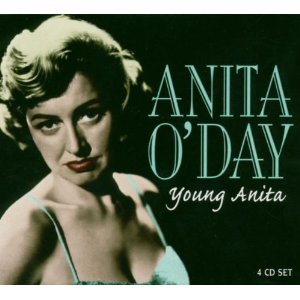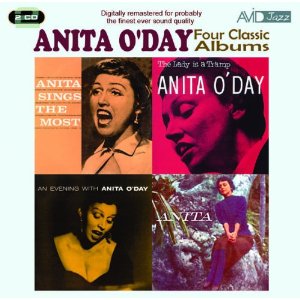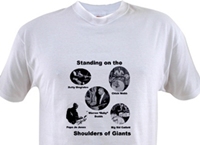While there are a number of albums that showcase Anita's big band years, the most economical I have found is a four disc set titled Young Anita.

For fans who mainly know Anita's work from her Verve and later years this is a wonderful glimpse into her early work. While she evolved into a hip, scatting vocalist who could keep up with the later bebop musicians, these tracks show why she was also an unquestionable talent during her early years.
Many of these tracks are also on Let Me Off Uptown: The Best of Anita O'Day with Gene Krupa and another compilation titled First Lady of Swing. The latter documents her time with Stan Kenton's band. This compilation - Young Anita - contains the pearls from both in my opinion. It does so in 89 tracks that are representative of not only Anita's early body of work, but of the era.
I personally love the selection of songs in this compilation. Every track is relatively well mastered (in other words, an audiophile may object, but considering the sources for mastering the sound quality is reasonable and listenable.) I cannot think of a single track that would showcase Anita's talents that was left out of this set. That speaks highly of whoever produced this compilation.
Of course this iconic track is included. I am posting the video version instead of the album one because they are nearly identical and it's always a treat to see a young Anita in action. This was considered controversial when it was released because of the rampant racism and segregation laws back then, but also there was some tension between Anita and Roy Eldridge who frequently complained that Anita was upstaging him.
Here is track 6 from disc 2:
A 1944 performance from her stint with Stan Kenton:
Another from her stint with Kenton (1944). She sounds a lot like Ella Mae Morse on this track.
I mentioned the similarity to Ella Mae Morse regarding the above track. Morse's career took a different turn with a progression from jump blues to early rock to rockabilly. Anita could have taken that path. Indeed, during the post swing era she and her contemporaries (and record labels) were desperately searching for the next big thing. Although the albums in this set are not from the big band era (and some are also included in the set discussed in Anita O'Day in depth Part 2), the bridge between her big band years and Verve years is contained in a two albums in the set.

The first album is The Lady is a Tramp

This album has had a twisting and turning genesis. The first eight tracks were recorded in 1952 and released under the title Anita O'Day Collates by Norgran Records in 1953. I actually wrote a comprehensive review of that album, which includes personnel and dates, and another perspective than what I am providing here for those who are interested in such things.
Norgran was Norman Granz' original label. Norgran then reissued the album in 1955 under the title Anita O'Day Sings Jazz. It was finally released in 1957 under the present title by Verve (which Granz established in 1956 and absorbed the Norgran catalog.) In addition to the original eight tracks, the final release contained four more.
The song selection is all over the place. By 1957 this selection was a bit odd, but when the original eight tracks were recorded in 1952 music was undergoing an upheaval. Jazz was being nudged out by popular music, some of which would become rock and roll, while other threads of that era would become rockabilly and other genres. The lack of homogeneity was because of the racial divisions in mainstream America at the time. It may sound ludicrous today, but the airwaves were culturally segregated. The point being that the inclusion of a track such as Rock 'N' Roll Blues was probably an attempt to grab onto what may have been seen as a trend, and to reach a wider audience by a new label (Norgran.) Ella Mae Morse whose big band roots were similar to Anita's was making inroads into the new trends, so that may have also been a factor. Other songs from the original eight recordings were standards and make sense.
The four additional tracks contained popular music such as Vaya Con Dios, and was probably included to increase the marketing range of yet another brand new label, Verve.
Regardless of the strange (but explainable) mix of songs and the twists and turns that started in 1952 and culminated in this album in 1957, O'Day is a constant factor. She makes each song her own. Listen to the song samples. If you are a fan, her imprint is unmistakable. And the mixed bag of songs, as incongruous as they are on one album, clearly shows her versatility. Moreover, this album - the first eight tracks anyway - capture her reinventing herself from big band vocalist to small ensemble diva. It also foreshadows her many reinventions that would take place over the next half century.
For those who are interested in who played what, here is the personnel list:
Tracks 1-4: Roy Eldridge on trumpet, Albert Johnson on tenor sax, Cecil Payne on baritone sax, Bill Harris on trombone, Ralph Burns on piano, Al McKibbon on Bass and Don Lamond on drums.
Tracks 6, 11 and 12: Roy Kral on piano, Earl Backus on guitar, John Frigo on bass, Bob Lionberg on drums and Jim Wilson on percussion.
Tracks 7 through 10: studio orchestra (arrangements by Larry Russell who also conducted).
To satiate any curiosity, here is Rock 'N Roll Blues from the album:
The other transitional album in the set is An Evening With Anita O'Day in which Anita engineers the first of her many reinventions and distances herself from the incoherent The Lady is a Tramp.

This album is not only coherent, but sets the tone for Anita's evolution from big band singer to small ensemble vocalist. Here she becomes the proven talent who not only shows she can adapt, but who would reinvent herself more than a few times in the ensuring half century. In my opinion, her first reinvention was during the sessions that resulted in this album.
Why this album is coherent is the song selection. There is an obligatory Cole Porter tune, plus standards like I Cover the Waterfront, The Man I Love and one song that Anita would make her own with numerous performances the rest of her life: Let's Fall In Love. Moreover, there is the traditional Frankie and Johnny, along with her own Anita's Blues. This stuff is beautifully suited to her vocal style and phrasing, unlike the proto rock of the 1952 album that featured honking sax on nearly every track. The contrast alone makes this album worth it.
Then there are the backing ensenbles. Although Anita would continue performing in the studio and even live with full orchestra backing, she seemed to be at her best with smaller groups, and this album marks her complete break from the big band era where she made her name with Gene Krupa, Woody Herman and Stan Kenton.
Personally, I love her the most backed by a piano trio, like in the second session on June 28, 1954 (see below). However, all three ensembles backing her on this album are perfect for the era and her style. Listen to the sound samples on this page to see what I mean.
I am including the list of personnel and dates of the sessions for those who are interested.
Session 1 April 15, 1954 (Anita had released from jail almost two months prior to this). Personnel: Arnold Ross on piano, Barney Kessel on guitar, Monty Budwig on bass and Jackie Mills on drums. The tracks cut during this session are:
The Gypsy In My Soul
Just One Of Those Things
The Man I Love
Frankie And Johnny
Session 2 June 28, 1954 - This is a perfect backing for Anita - a piano trio comprised of Bud Lavine on piano, Monty Budwig on bass and John Poole on drums. Note: this is the first appearance of John Poole with Anita. He would remain with her for over four decades. I do not know if this was a chance pairing and they reconnected later because she mentioned in Anita O'Day - The Life Of A Jazz Singer that she first met him at a girlie show in Long Beach (right outside of LA.) The tracks are:
Anita's Blues
I Cover The Waterfront
I Didn't Know What Time It Was
Let's Fall In Love
Session 3 was over a year later on August 11, 1955. Personnel:
Jimmy Rowles on piano, Tal Farlow on guitar, Leroy Vinnegar on bass and Larry Bunker on drums. Tracks cut during this session:
You're Getting To Be A Habit With Me
From This Moment On
You Don't Know What Love Is
Medley
Here is a track from the album:
I'll wrap this up for the time being. I have a lot of material to add to the Anita O'Day story and body of work, but will cover other topics before I take this up again with part 4. Until then, keep swinging and enjoy the music.



1 comment:
thanks for this wonderful analysis!!!
Post a Comment